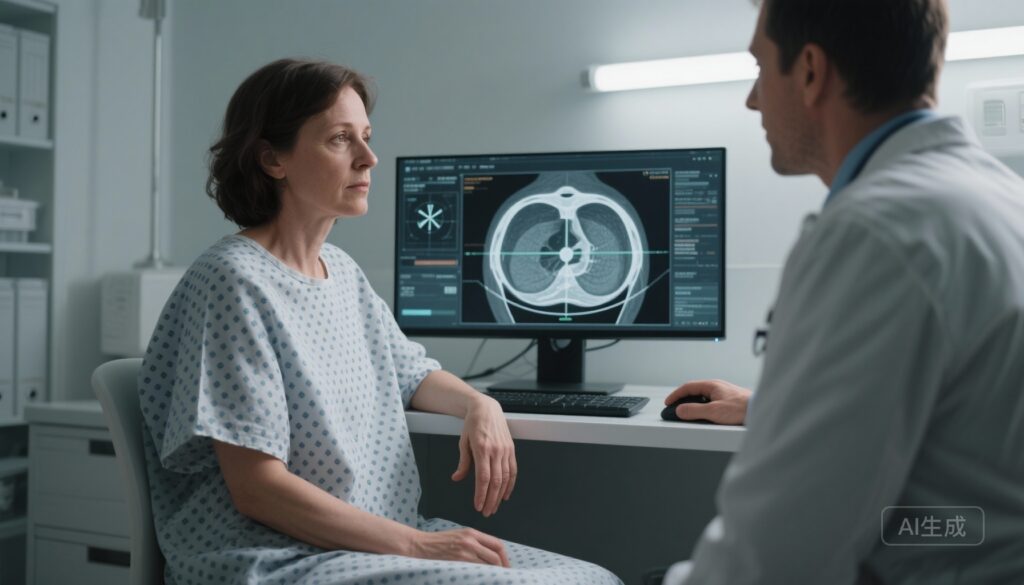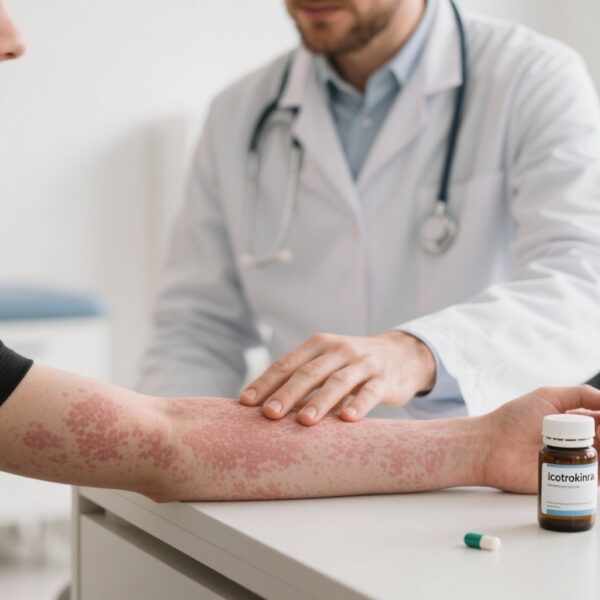Highlights
– The SUPREMO randomized phase 3 trial (n≈1607) compared chest‑wall irradiation versus omission after mastectomy in intermediate‑risk breast cancer and found no improvement in 10‑year overall survival (OS).
– Chest‑wall irradiation halved the hazard of local (chest‑wall) recurrence (absolute difference <2%) but produced no meaningful difference in disease‑free survival or distant metastasis‑free survival at 10 years.
– An emulation of SUPREMO using the National Cancer Database (n=49,335) likewise found no OS benefit for PMRT overall, but a survival benefit was suggested for the pT3N0 subgroup.
– Contemporary guidelines (ASTRO/ASCO/SSO) continue to recommend PMRT for many node‑positive and selected node‑negative patients; individualization remains essential.
Background and clinical context
After mastectomy, postmastectomy radiation therapy (PMRT) can reduce local‑regional recurrence and, in some high‑risk populations, improve survival. The magnitude of benefit depends on baseline risk, extent of nodal involvement, tumor biology, and systemic therapy. Historically, randomized data and meta‑analyses (including the Early Breast Cancer Trialists’ Collaborative Group [EBCTCG]) established survival benefits of radiotherapy in patients with four or more positive nodes and reductions in recurrence for lower‑node disease. However, the optimal use of chest‑wall irradiation in patients with “intermediate‑risk” disease (pathologic node status pN1 [1–3 positive nodes], or selected pN0 patients with adverse features) has been uncertain, especially in the era of modern systemic therapy and improved supportive care.
Study designs
SUPREMO randomized trial (Ten‑Year Survival after Postmastectomy Chest‑Wall Irradiation)
Design: International, phase 3 randomized trial. Population: Women treated with mastectomy and systemic therapy who had intermediate‑risk breast cancer defined as pT1N1, pT2N1, pT3N0, or pT2N0 with grade 3 histology and/or lymphovascular invasion. Intervention: Chest‑wall irradiation (40–50 Gy) versus omission of chest‑wall irradiation. Primary endpoint: Overall survival at 10 years. Secondary endpoints: Chest‑wall recurrence, regional recurrence, disease‑free survival (DFS), distant metastasis‑free survival, cause‑specific mortality, and radiation‑related adverse events. Registration: SUPREMO ISRCTN 61145589. Funding: Medical Research Council and others.
Real‑world emulation (Kulkarni et al., NCDB)
Design: Retrospective cohort study using the National Cancer Database to emulate SUPREMO eligibility (2006–2013). Population: 49,335 mastectomy patients meeting intermediate‑risk criteria; 6,882 (13.9%) received PMRT. Analyses: Multivariable logistic regression, Cox proportional hazards, and stabilized inverse probability of treatment weighting to estimate effect of PMRT on OS; subgroup interaction analyses (notably pT3N0).
Key findings
Primary randomized evidence (SUPREMO)
Population: Intention‑to‑treat included 808 patients assigned to irradiation and 799 to no irradiation; median follow‑up 9.6 years.
Overall survival: 10‑year Kaplan‑Meier OS was 81.4% in the chest‑wall irradiation group versus 81.9% in the no‑irradiation group (hazard ratio [HR] for death 1.04; 95% CI, 0.82–1.30; P=0.80). No OS advantage was observed with chest‑wall irradiation.
Chest‑wall recurrence: 29 patients developed chest‑wall recurrence — 9 (1.1%) in the irradiation group and 20 (2.5%) in the no‑irradiation group. Absolute difference was <2 percentage points; HR for chest‑wall recurrence 0.45 (95% CI, 0.20–0.99), indicating approximately a halving of risk but with a very small absolute benefit in this population.
Disease‑free and distant metastasis‑free survival: DFS at 10 years was 76.2% with irradiation vs 75.5% without (HR for recurrence or death 0.97; 95% CI, 0.79–1.18). Distant metastasis‑free survival was 78.2% vs 79.2% (HR 1.06; 95% CI, 0.86–1.31). No statistically significant benefits for these endpoints were reported.
Safety and causes of death: Radiation‑related adverse events were assessed but not associated with a detectable increase in mortality; causes of death distribution was similar between arms. SUPREMO did not show a survival detriment from radiation in this follow‑up period.
Real‑world evidence (NCDB emulation)
Overall cohort: Among 49,335 patients, PMRT was not associated with improved overall survival after adjustment (HR 0.98, 95% CI 0.92–1.04). This mirrors the overall SUPREMO result.
Subgroup signal: Improved OS was observed in the pT3N0 subgroup (HR 0.72, 95% CI 0.58–0.89), suggesting women with larger primary tumors (T3) without nodal metastases may derive survival benefit from PMRT. Patients with 1–3 positive nodes or positive margins were more likely to receive PMRT in clinical practice.
Limitations: As a retrospective registry analysis, selection bias, confounding by indication, and unmeasured variables (e.g., systemic therapy details, biologic subtype, margin status nuances) can affect estimates, even after statistical adjustments.
Interpretation and expert commentary
Clinical interpretation: SUPREMO provides randomized evidence that, for a broad group of patients categorized as intermediate‑risk and treated with contemporary systemic therapy, chest‑wall irradiation after mastectomy reduces local chest‑wall recurrence but does not improve 10‑year overall survival. The absolute reduction in chest‑wall recurrence was small (<2%), raising questions about the routine use of chest‑wall irradiation for all intermediate‑risk patients.
Biological and therapeutic context: Improvements in systemic therapy (taxanes, anthracyclines, targeted agents, endocrine therapy) and better surgical staging likely reduced baseline event rates relative to older trials, diminishing the marginal benefit of local radiation on survival. When baseline rates of local failure are low, large reductions in local recurrence may not translate into detectable survival gains within a decade.
Guideline alignment: Contemporary ASTRO/ASCO/SSO guidance (2025) continues to recommend PMRT for most node‑positive patients and selected node‑negative patients with high‑risk features, and recommends treatment of chest wall and regional lymphatics when PMRT is delivered. These guideline recommendations integrate multiple lines of evidence and emphasize individualized decision‑making, taking into account tumor size, nodal burden, margin status, biologic subtype, patient comorbidity, and reconstruction plans.
Subgroup considerations: The NCDB emulation suggests a potential survival benefit for pT3N0 patients; biologically, larger tumors might have higher rates of occult regional disease and systemic relapse, and PMRT could reduce locoregional seeding that contributes to distant spread. However, such subgroup findings in observational data should be considered hypothesis‑generating and require corroboration.
Limitations and unanswered questions
SUPREMO limitations: The trial evaluated chest‑wall irradiation specifically (dose 40–50 Gy) and not comprehensive regional nodal irradiation as a uniform strategy; differences in regional nodal management across centers could affect regional control outcomes. Some subgroup analyses were underpowered to detect modest survival differences. The median follow‑up of 9.6 years is robust, but longer follow‑up could reveal late‑emerging differences, particularly for certain subtypes (e.g., luminal disease).
Generalizability: SUPREMO participants received contemporary adjuvant systemic therapy but exact regimens and biologic subtype distribution will influence applicability. Real‑world populations may differ in comorbidity, adherence, and access to modern systemic agents.
Radiation technique and toxicity: Modern planning (CT‑based 3D conformal RT, intensity‑modulated RT, deep inspiration breath‑hold) improves normal‑tissue sparing versus older techniques. Toxicity profiles and cardiac risk mitigation are important when weighing small absolute local control benefits against potential late harms.
Clinical implications and practical recommendations
– For most intermediate‑risk patients (pT1‑2N1, selected pT2N0 Grade 3/LVI), routine chest‑wall irradiation solely to improve OS is not supported by the SUPREMO 10‑year results. Shared decision‑making should emphasize the small absolute reduction in chest‑wall recurrence, patient preferences about recurrence risk, and potential treatment morbidity.
– Consider PMRT when other risk modifiers are present: positive margins (especially superficial/skin involvement), extensive lymphovascular invasion, young age, aggressive molecular subtype, or circumstances that increase local recurrence risk despite node count.
– For pT3N0 patients, the NCDB emulation raises the possibility of survival benefit; in such cases clinicians should consider PMRT more strongly and weigh individual factors (reconstruction, comorbidity, subtype) while awaiting further confirmatory data.
– When PMRT is used, adhere to guideline techniques: CT‑based volumetric planning, moderate hypofractionation where appropriate, and techniques to minimize cardiac and pulmonary dose (e.g., deep inspiration breath hold). Include regional nodes per guideline indications.
Conclusions and research priorities
SUPREMO contributes high‑quality randomized evidence that chest‑wall irradiation reduces local recurrence but does not improve 10‑year overall survival for a broadly defined intermediate‑risk postmastectomy population treated with modern systemic therapy. Large real‑world data support the lack of benefit for OS overall but suggest a possible benefit in pT3N0 disease. Clinicians should individualize PMRT decisions, integrating tumor factors, patient values, and technical considerations. Future research priorities include longer follow‑up for SUPREMO, pooled or meta‑analytic subgroup analyses combining trials and contemporary registries, prospective evaluation of PMRT in T3N0 patients, and trials that stratify by molecular subtype and use modern systemic standards to define who benefits most from locoregional radiation.
Funding and trial registration
SUPREMO was funded by the Medical Research Council and others; trial registration: SUPREMO ISRCTN Clinical Study Registry number 61145589.
References
1. Kunkler IH, Russell NS, Anderson N, et al.; SUPREMO Trial Investigators. Ten‑Year Survival after Postmastectomy Chest‑Wall Irradiation in Breast Cancer. N Engl J Med. 2025 Nov 6;393(18):1771–1783. doi:10.1056/NEJMoa2412225. PMID: 41191939.
2. Kulkarni SE, Patel SA, Jiang C, et al. Postmastectomy Radiation Therapy for Intermediate‑Risk Breast Cancer Patients With 0‑3 Positive Axillary Lymph Nodes: Emulating the SUPREMO Trial Using Real‑World Data. Clin Breast Cancer. 2025 Jul;25(5):e655–e665.e4. doi:10.1016/j.clbc.2025.03.007. PMID: 40187907.
3. Jimenez RB, Abdou Y, Anderson P, et al. Postmastectomy Radiation Therapy: An ASTRO/ASCO/SSO Clinical Practice Guideline. Pract Radiat Oncol. 2025 Nov‑Dec;15(6):549–571. doi:10.1016/j.prro.2025.05.001. PMID: 40956255.
4. Early Breast Cancer Trialists’ Collaborative Group (EBCTCG). Effect of radiotherapy after mastectomy and axillary surgery on 10‑year recurrence and 20‑year breast cancer mortality: meta‑analysis of individual patient data for 8135 women in 22 randomized trials. Lancet. 2014;383:2127‑2135.



